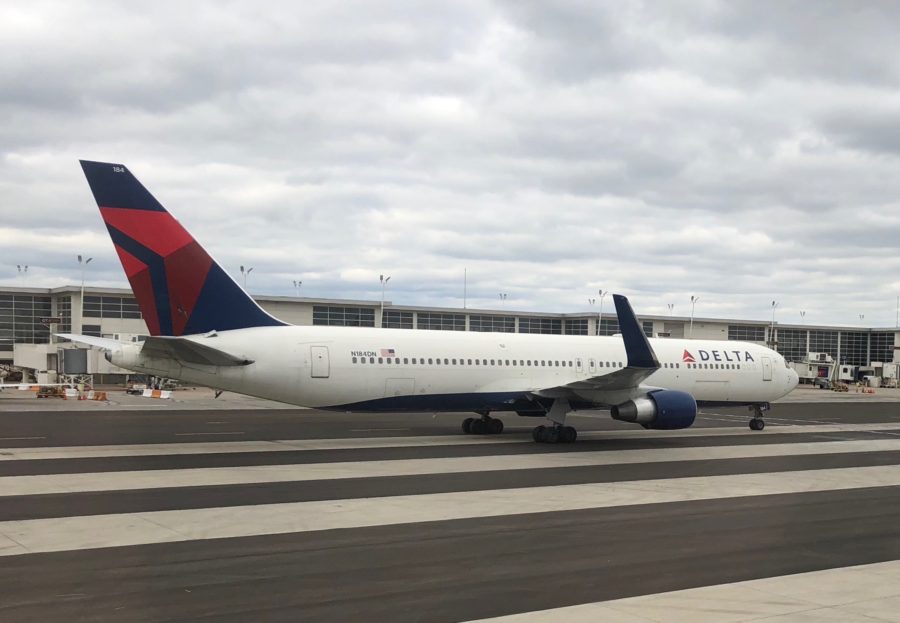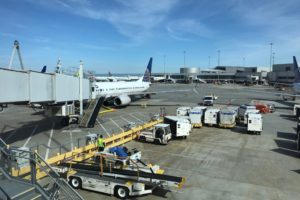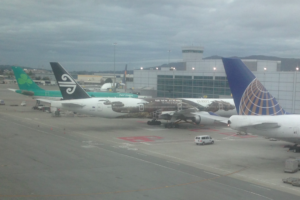The Future Fleet Plans Of Delta Air Lines
Featured Image: A Delta Air Lines Boeing 767-300ER at Detroit International Airport
- The Future Fleet Plans of United Airlines
- The Future Fleet Plans of American Airlines
- The Future Fleet Plans of Delta Airlines
In this article (and the ones on United and American), I will examine the future fleet plans of Delta Air Lines. What I will do is explain which aircraft Delta will replace in the future, which ones they have on order, what the interiors of the aircraft on order are and the ones that they will replace have. Delta has a pretty mixed fleet, with both aging aircraft such as the MD-88 or the Boeing 757 and also with many new aircraft such as the Airbus A350 and A220. They have many Airbus A330neos on order but also have a huge number of A321neos on order, which they will take delivery of within the next few years.
Regional Fleet Plans:
Delta’s regional brand is called Delta Connection and leases planes from smaller contract carriers which include Compass Airlines, Endeavor Air, Republic Airline, GoJet Airlines, and SkyWest Airlines. Delta Connection currently operates the Bombardier CRJ-200, CRJ-700, CRJ-900, the Embraer, E170, and the E175. Their CRJ-200s are in a single class configuration while their CRJ-700s, CRJ-900s, E170s, and E175s are in a two-class configuration. All aircraft have economy class in a 2-2 configuration while aircraft which have first-class feature recliner seats which are in a 1-2 configuration. Additionally, some CRJ-700s, all CRJ-900s, all E170s, and all E175s are equipped with personal device entertainment where you can stream content to your personal device free of charge.
Delta actually over the past few years has significantly decreased the number of small regional aircraft that they operate. While in 2012, they had over 350 50 seat aircraft such as the CRJ-200 or E145, they now have decreased the number of such planes to around 150 CRJ-200s. This is because Delta has been replacing them with larger aircraft which are more spacious, have premium cabins, and then operate at a reduced frequency but still transport more passengers.

On order, Delta only has 14 CRJ-900s which it will use to replace some of its older regional fleet. This is because they are using a new mainline aircraft to replace much of their regional fleet. The aircraft aren’t operated by Delta Connection but are run by Delta Air Lines itself. Delta recently took delivery of their first Airbus A220s which have 109 seats, a first class cabin, a long range, and have personal on-demand entertainment screens at every seat. The plane is exceptionally comfortable for passengers, is very modern, and is without a doubt better than tiny CRJs or ERJs. They aren’t precisely regional aircraft but are the replacement for many of them which is why I included them in this section. They will take delivery of a total of 90 of them which Delta will use to replace some of their older CRJ-700s, CRJ-900s, and Embraer E170s.
Narrowbody Fleet Plans:
As stated earlier, Delta’s newest narrow-body aircraft is the Airbus A220, although I won’t cover it anymore in this section as it largely replaced their regional aircraft. Delta’s narrowbody fleet consists of the Airbus A220, Airbus A319, Airbus A320, Airbus A321, Boeing 717, Boeing 737-700, Boeing 737-800, Boeing 737-900, the McDonnell Douglass MD-88, and MD-90. First off, Delta despite being the best of the three major US airlines operates the largest fleet of DC-9 type aircraft. What I mean is that they operate a large amount of extremely old MD-80 series aircraft such as the MD-88, MD-90, and the Boeing 717. These aircraft have two engines in the rear of the aircraft and are all pretty dated and old. All three aircraft types are variations on the DC-9 (the MD-88 and MD-90 are stretched versions of the aircraft while the 717 is the newest version which Boeing produced for a very short period of time before discontinuing it).

Their 717s were all recently acquired around 2014 after AirTran was bought by Southwest and didn’t want to keep the aircraft. The planes are now operating for Delta who now operates 91 of them on regional to short-haul routes. They also still have over 100 MD-88s/MD-90s which were both discontinued 20 years ago! Delta is the last operator of the MD-90 and is one of the last operators of the MD-88. Fortunately, most of the aircraft actually are well maintained and aren’t too dated (they have WiFi and Personal Device Entertainment), and their MD-88s and MD-90s all are slated for complete retirement within the next few years. Unfortunately, there are no immediate retirement plans for their Boeing 717s which will stay in their fleet for at least a few more years.
Delta also operates almost 130 Boeing 757s, including the 757-200 and 757-300. Their 757-300s and the majority of 757-200s are in a domestic configuration and feature recliner seats in First Class and have personal on-demand or personal-device entertainment. These aircraft are used on high-density routes within the US or to Hawaii and the Caribbean and are currently being replaced by the Airbus A321. They also operate a smaller fleet of internationally configured 757-200s which have flat-bed seats in business class in a 2-2 configuration and have personal on-demand entertainment at every seat. The aircraft are primarily used on transcontinental routes such as from New York to San Francisco, Washington DCA to Los Angeles, or Boston to Los Angeles which have enhanced services including Delta One amenities in business. They are also used on a handful or long-haul routes such as from New York to Lisbon or Dakar or from Boston to Dublin or Edinburgh. These aircraft have no imminent retirement plans.

On the newer end of their narrowbody fleet, Delta has a large fleet of modern 737-700/800/900s and also has many Airbus A319s, A320s, and A321s. All 737s and A321s and most A319s and A320s feature personal on-demand entertainment which gives you access to hundreds of free movies and tv shows. Delta is the only airline out of United, American, and Delta to have personal screens on the vast majority of short-haul aircraft. The A320s and A319s which do not have personal on-demand entertainment feature free personal device entertainment. As opposed to United and American that don’t have personal screens on new aircraft, Delta has put personal screens on all of their new aircraft. Delta has a whopping 100 Airbus A321neos (new engine option) on order and has over 50 A321s (current engine option/ceo) on order which all will replace their older MD-88s and MD-90s which they have had for so many years. Overall, Delta’s narrowbody fleet is pretty mixed with many old aircraft but also with many new aircraft, and will just get even more modern over the next years.
Widebody Fleet Plans:
Delta’s long-haul fleet consists of the Airbus A330-200, Airbus A330-300, Airbus A350-900, Boeing 767-300, Boeing 767-400, and the Boeing 777-200/200LR. All aircraft have WiFi and personal on-demand entertainment at every seat. In business class (Delta One), their 767s have the Thompson Vantage seat model which is in a staggered 1-2-1 configuration, although the seats are reported to be extremely tight on this aircraft model. Their Airbus A330s all feature reverse herringbone seats in a 1-2-1 configuration using the Zodiac (now Safran) Cirrus seat model which is a very popular seat model also used on Air France or China Eastern Airlines. Delta’s non-retrofitted 777s feature herringbone seats in a 1-2-1 configuration which face into the aisle and are known not to be especially comfortable.
Delta’s retrofitted 777s and all of their A350s feature closed suites (with doors) in a 1-2-1 staggered configuration (read a review here) which are extremely private, have a lot of storage and are based on the Thompson Vantage XL seat model. Their 777s and A350s with the new seats also feature Delta’s new premium economy product, Premium Select. Delta plans to retrofit all of their 777s and some of their 767s with this seat model.

Delta already have taken delivery of around 12 Airbus A350-900s and will continue to take delivery of around 13 of them over the next few years. However, the last 10 of them have been deferred for delivery until the mid-2020s. Additionally, Delta plans to retire the majority of their Boeing 767-300s over the next couple of years and retrofit the rest (including all of their 767-400s) of them with their new premium economy and Delta One products. Their Airbus A330s don’t have any plans for retirement or business class refurbishment yet, although they do plan to retrofit them with Premium Select in an undisclosed future period in the future.
Delta also currently has 35 Airbus A330-900neos on order. The aircraft recently began service with TAP Portugal and is essentially an enhanced version of the A330-300. These aircraft are intended to replace Delta’s aging 767-300s on transatlantic or transpacific routes and will start being delivered this year. They will have 281 seats including 29 Delta One Suites and a Premium Select section. Overall, Delta will keep getting A350 deliveries, will keep and retrofit their A330s, 777s, and some 767s, and will take delivery of some A330neos which will replace their older 767-300s.

Conclusion:
Delta Air Lines actually has the oldest fleet of the three major US airlines. However, they also have the nicest as they are adding quality in-flight entertainment to more and more aircraft, have new cabins, and have some of the best business class seats in the world on their long-haul flights. Yes, their MD-88s are pretty old, but they will soon be replaced by A321s. I also commend them for retiring many 50- or 70-seater regional jets in favor of the mainline Airbus A220 in which their cabin is extremely passenger friendly for the short routes that it operates. Overall, Delta’s fleet is on average pretty old, but their quality of maintenance of the aircraft and fantastic new planes definitely make up for that.
What do you think of Delta Air Lines’ Fleet?




